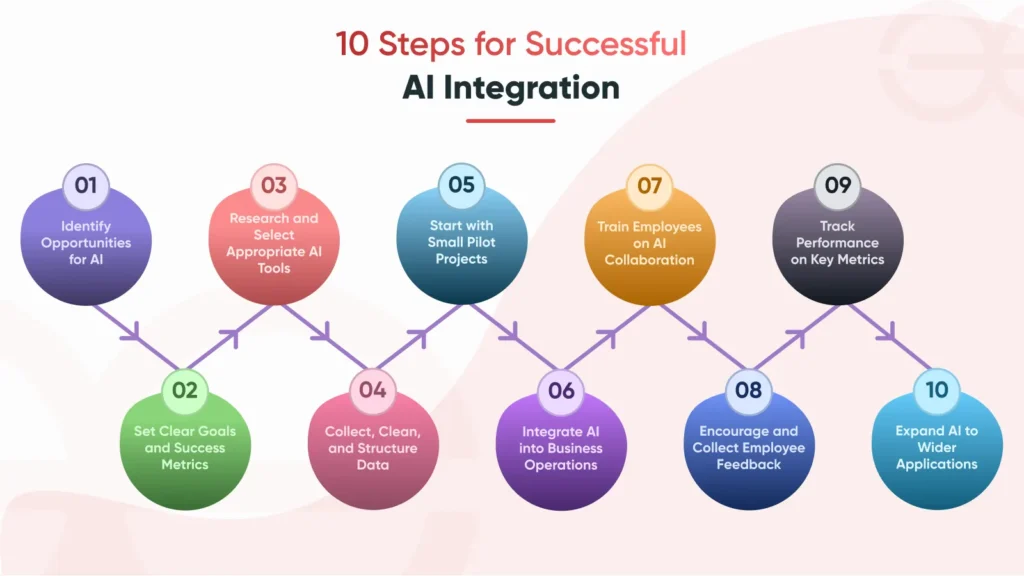AI in Small Business: (2024) Comprehensive Integration Guide
What if small businesses could use generative AI to improve their growth and efficiency like big organizations? Well, there is good news for small business owners – With AI becoming more accessible than ever in 2024, now is the time for small businesses to harness this emerging technology.
But where do you start on your AI integration journey? How can you implement AI in small businesses that provide real impact without huge investment? Which areas of your small business are suitable for AI optimization? By asking the right strategic questions and aligning on clear AI goals – small businesses can pave the way for transformative change.
But integrating AI in small business is not an easy nut to crack…
In this comprehensive integration guide, we’ll explore the tailored AI capabilities that small businesses need to succeed in 2024 and beyond. Let’s dive into how to make AI integration attainable for forward-thinking small businesses.
10 Steps for Successful AI Integration

Integrating AI in small business may seem daunting, but it doesn’t have to be with the right strategic approach. By following these 10 steps, you can integrate AI in mobile Apps while leveling up your overall game. Remember, laying the proper groundwork and foundations will ensure the AI application development delivers maximum value and becomes a seamless part of your workflow.
1. Identify opportunities for AI
Thoroughly audit all your business processes and workflows across departments to identify opportunities for AI automation and augmentation. Before you create app using AI, look for repetitive manual tasks, data analysis, and customer interactions that could be enhanced by AI.
You need to prioritize opportunities based on potential return on investment. Set tangible goals like reducing costs or improving accuracy by specific percentages. Keep in mind, that you don’t have to automate just for the sake of it – identify how AI integration can concretely improve your overall performance.
2. Set Clear Goals and Success Metrics
Clearly define specific, measurable goals and key performance indicators for integrating AI in small business. Remember, your quantifiable metrics should include reducing costs by a percentage, saving a set number of hours per week, increasing data accuracy by a percentage, or improving customer satisfaction scores.
These goals will guide your AI approach, tool selection, and implementation strategy. Most importantly, you need to continuously evaluate progress on these success metrics to prove the value of AI and identify areas for improvement.
3. Research and Select Appropriate AI Tools
With the variety of AI tools available, it’s pretty important to thoroughly research options before selecting any. Analyze different solutions in areas like machine learning, NLP, and predictive analytics to find ones that align with your specific business goals and data types.
Don’t forget to consider long-term costs, scalability requirements, and ease of integrating with your existing systems. Besides, you need to make informed selections based on real capabilities, not hype. Lastly, shortlist vendors that offer robust documentation, training resources, and ongoing support for AI in small businesses.
4. Collect, Clean, and Structure Data
AI in apps relies on quality, well-organized data. All you need to do is… aggregate relevant structured and unstructured data from across your organization into a master dataset for training algorithms. Moreover, invest time upfront to clean the data by removing errors, redundancies, and inconsistencies. Carefully structure and label the data so AI models can accurately interpret relationships and patterns during training. Bear in mind, that quality training data is essential for building effective AI.
5. Start with Small Pilot Projects
Before the full rollout of AI integration, run small-scale pilot projects in limited low-risk operational areas. Integrating AI in small business with pilots allows you to test system functionality, workflows, and interfaces to catch problems early. Besides, you must gather feedback through surveys and interviews to identify issues and fine-tune the AI system based on user experiences.
Well, starting small allows you to smooth out inevitable hiccups without major disruptions. AI application development services providers always use lessons from pilots to optimize training data, system configurations, and employee training before company-wide implementation.
6. Integrate AI into Business Operations
Once piloted, you need to integrate the refined AI system into actual business operations, workflows, and tools that your employees use daily – including CRM, ERP, email, etc. Remember, your AI should seamlessly fit into existing processes versus radically changing them overnight.
You need to make adoption easy by providing training resources like how-to guides, videos, and FAQs. Of course, it is a little difficult for employees to accept the change. Monitor usage data and feedback to optimize integration. The goal is frictionless human-AI collaboration.
7. Train Employees on AI Collaboration
Your training sessions would ensure that employees understand how to best utilize AI in their roles. Don’t forget to provide clear guidelines and ongoing education focused on optimizing human-AI collaboration for your most important business objectives.
Make training interactive and role-based using real operational examples. Reinforce that AI aims to augment human capabilities, not replace jobs. Besides, address concerns about AI in small businesses transparently… by doing so, your skilled employees will surely amplify the business impact of AI.
8. Encourage and Collect Employee Feedback
Continuous employee feedback improves AI application development over time. Regularly collect input through interviews, surveys, focus groups, and other channels. Encourage both positive and constructive feedback.
Analyze feedback to understand the limitations and opportunities of AI integration from real user experiences. In addition, use insights to iteratively enhance the AI, address frustrations, and increase adoption. Remember, your satisfied employees will further amplify AI’s business impact as we mentioned earlier.
9. Track Performance on Key Metrics
To be precise, it is not easy to integrate AI in small business… you must rigorously track performance on key metrics tied to your AI goals – including costs decreased, accuracy improved, and revenue increased. Further, establish processes for ongoing data collection and analysis to quantify the AI impact over time. Be sure to report insights to leadership and employees. You can also use metrics to showcase ROI and identify areas needing improvement.
10. Expand AI to Wider Applications
Once successful, strategically expand AI into other business processes and workflows beyond the initial use cases. Moreover, prioritize new applications based on their ability to drive efficiencies, competitive advantage, and growth that align with overall objectives. Incrementally scale AI in small businesses but avoid overextending too quickly. Not to mention, following the same measured approach that made the initial launch successful.
Benefits of AI Integration
Indeed, integrating AI capabilities into existing systems and workflows has the potential to drive efficiencies, uncover insights, and augment human capabilities. Read on to check the benefits.
- Automating Manual Tasks
AI tools like robotic process automation can replicate repetitive administrative tasks accurately and efficiently. This saves employees time for more strategic work. For example, AI can process invoices, schedule appointments, file documents, etc. Ultimately, this improves productivity and reduces costs.
- Enhanced Data-Driven Decision Making
Create app using AI if you want to rapidly analyze large datasets from across business units to uncover actionable insights. Tools like predictive analytics help forecast sales, detect fraud, anticipate supply chain issues, etc. This enables data-based decision-making.
- Improved Customer Experiences
Chatbots with natural language capabilities can handle customer inquiries 24/7. Voice AI provides seamless self-service options via phone. Besides, recommendation engines personalize eCommerce experiences while driving customer satisfaction higher.
- New Revenue Streams and Business Models
AI integration unlocks new products and revenue like computer vision for image analysis or predictive analytics for risk modeling. It also enables innovative business models based on AI services.
- Increased Consistency and Compliance
Integrating AI in small business reduces human error and bias by standardizing processes like contract review, claims processing, etc. according to compliance rules. This boosts legal and regulatory compliance.
Challenges of Implementing AI
Well, there is no such thing as a free lunch… AI in small business can present a number of challenges for organizations including:
- Upfront Costs and Resource Requirements
AI software, tools, infrastructure, and services can be expensive. Besides, the implementation requires extensive IT staff time and may need outside consultants as well. Ongoing training and headcount are also needed which strains limited resources.
- Integration Complexities
Connecting AI in small businesses to legacy IT systems and workflows can require custom development. Plus, cleaning and preparing data for training can also take considerable effort.
- Change Management Concerns
Employees may lack trust in AI or feel threatened by it… and that is pretty normal. They will need training on working alongside AI tools. Better yet, clear communication about AI’s role is vital for adoption.
- Potential Lack of Suitable Data
AI algorithms require large training datasets which small businesses may lack, especially for niche use cases. Above and beyond, acquiring the right data can be difficult.
- Avoiding Algorithm Bias
With limited data, AI integration bias can emerge… Continual oversight is required to keep algorithms transparent and ensure recommendations are fair and ethical.
Wrapping Up
There is no second thought about it that the AI integration journey requires thoughtful strategy and planning to yield real business impact – and the future of AI businesses is pretty bright. But with the right approach, small businesses can harness AI’s power to optimize operations, lower costs, boost efficiency, and drive growth – just like enterprise players.
By starting with targeted use cases, setting quantitative goals, piloting projects, integrating into workflows, training employees, gathering feedback, and iterating based on data – small businesses can overcome integration hurdles. Besides, with each successful launch your AI’s value proposition would become clearer.
While AI adoption requires upfront investment, the long-term benefits of optimized processes and elevated capabilities outweigh the costs. In 2024, AI is more accessible than ever before – the time is now for forward-thinking small businesses to leverage AI and gain a competitive edge. If you still need help in integrating AI in small business – Geeks of Kolachi has the savvy and technical skills to assist.
FAQs:
- What are some best practices for training employees on AI tools?
Provide role-based hands-on training with real examples. Emphasize AI collaboration, not replacement. Have experts address concerns transparently. Offer ongoing education as AI evolves.
- How can I choose the right AI vendor for my small business? Or how to invest in AI startups
Analyze vendors based on costs, capabilities, integration options, scalability, and training/support offered. Select one that aligns with your goals and data needs. Avoid hype and focus on real solutions.
- What steps can I take to prevent algorithm bias in my AI models?
Carefully clean and label training data. Continuously audit algorithms and tweak models to ensure fairness. Maintain transparency in AI decision-making. Actively monitor for unintended bias.
- How long does it take to see ROI from AI implementation?
Depends on the use case complexity and scale of integration. For focused initiatives, results can be seen in 3-6 months. Larger implementations may take 6-12+ months. Set targets and track metrics to prove ongoing value.
- Can AI fully automate all my business processes?
AI excels at specific tasks but humans still handle strategy, creativity, and complex decisions. Take a hybrid approach with AI augmenting human skills for balance. AI and humans complement each other.




















